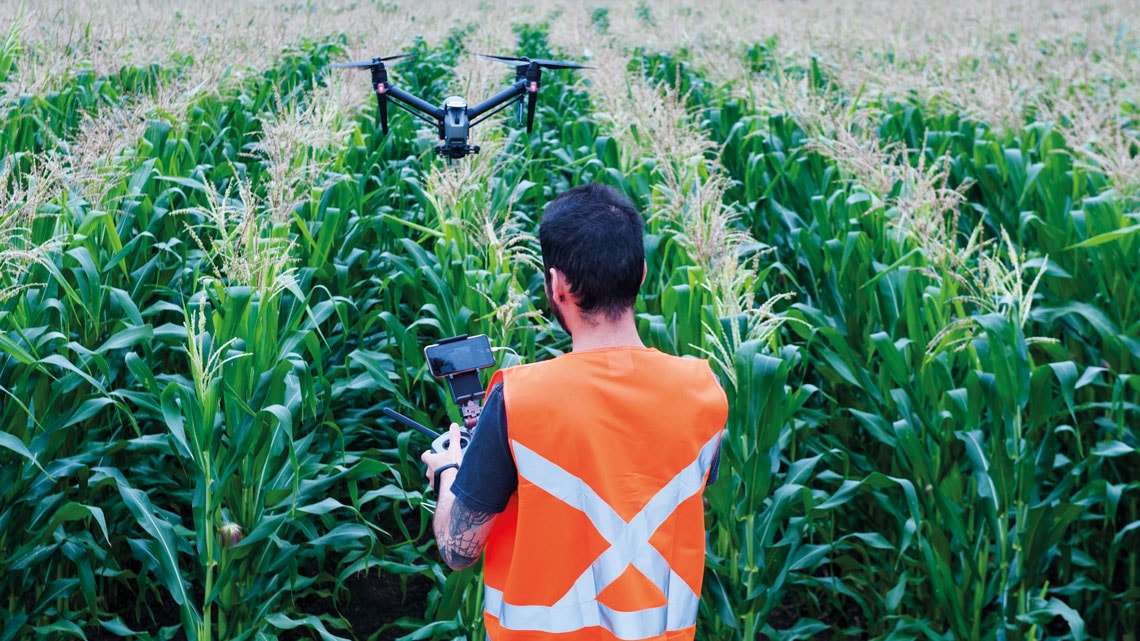The use of information technology (IT) is changing the face of farming. From relying on tradition, experience, or intuition in decision-making, farmers are now leveraging precise information in real time for decision support. In recent years, ground sensors, drones, satellite tracking systems, and other devices have been introduced in farming to collect data on variables affecting yields, such as soil properties, weather changes, and pest attacks. Farm tractors and machinery are now equipped with systems by which they can be remotely monitored and operated, improving farm management. Software systems are being used to manage data. Now, these systems are being linked together in the next revolution in agribusiness.
“Brazil has taken a leading role in deploying information technology in agriculture,” says Silvia Massruhá, head of the Agricultural Information Technology chapter at the Brazilian Agricultural Research Corporation (EMBRAPA), an institution that is pioneering the development of digital solutions. She notes that IT systems have seen growing use in farming, especially in the production of commodities such as soybeans, maize, cotton, sugarcane, citric fruits, coffee, and beef. Now the country is preparing to go to the next level with agriculture 4.0.
Agriculture 4.0 is about connecting the data being collected by digital systems in real time to optimize each stage of the supply chain, explains Massruhá. It’s the arrival of the Internet of Things (IoT) in agriculture. “In the future, farming will be autonomous. Interconnected equipment, powered by artificial intelligence and machine learning, will analyze and act on data collected across the supply chain. A farmer’s job will be to track, monitor, and endorse the processes that are ongoing,” says Fernando Martins, who works as a consultant for agribusiness technology firms.
The most recent Agricultural Census by the Brazilian Institute of Geography and Statistics (IBGE) showed that 1.5 million growers now access data using electronic devices (see article on page 26), a figure 1,900% higher than 10 years ago, denoting a high rate of digital adoption. “Process digitization, however, requires rural telecommunications infrastructure that in Brazil is still limited. It’s our Achilles’ heel,” says Massruhá.
A paper published by the Luiz de Queiroz School of Agriculture (ESALQ) at the University of São Paulo (USP) shows that only 5% of the country’s cropland, mostly large properties, is connected to the internet—Brazil is sorely lacking in connection infrastructure, and the cost of building that infrastructure will need to be borne by telecommunications companies, governments, or farmers. Expanding coverage to around 90% will require some 16,000 new transmission towers, says Luis Claudio Rodrigues de França, director of the Department of Agricultural Innovation Support at the Ministry of Agriculture and Food Supply (MAPA). The investment required would be in excess of R$8 billion. “The connectivity gap is the biggest barrier to advancing agriculture 4.0 in Brazil,” says França.
MAPA, he continues, is conducting a survey of the status of rural connectivity in the country. The study is evaluating the potential use of existing connection infrastructure, such as repeater antennas at road police stations and fiber-optic networks that can share rights-of-way with power transmission lines. The results from the survey will inform a national rural connectivity plan that the government plans to launch in 2020.
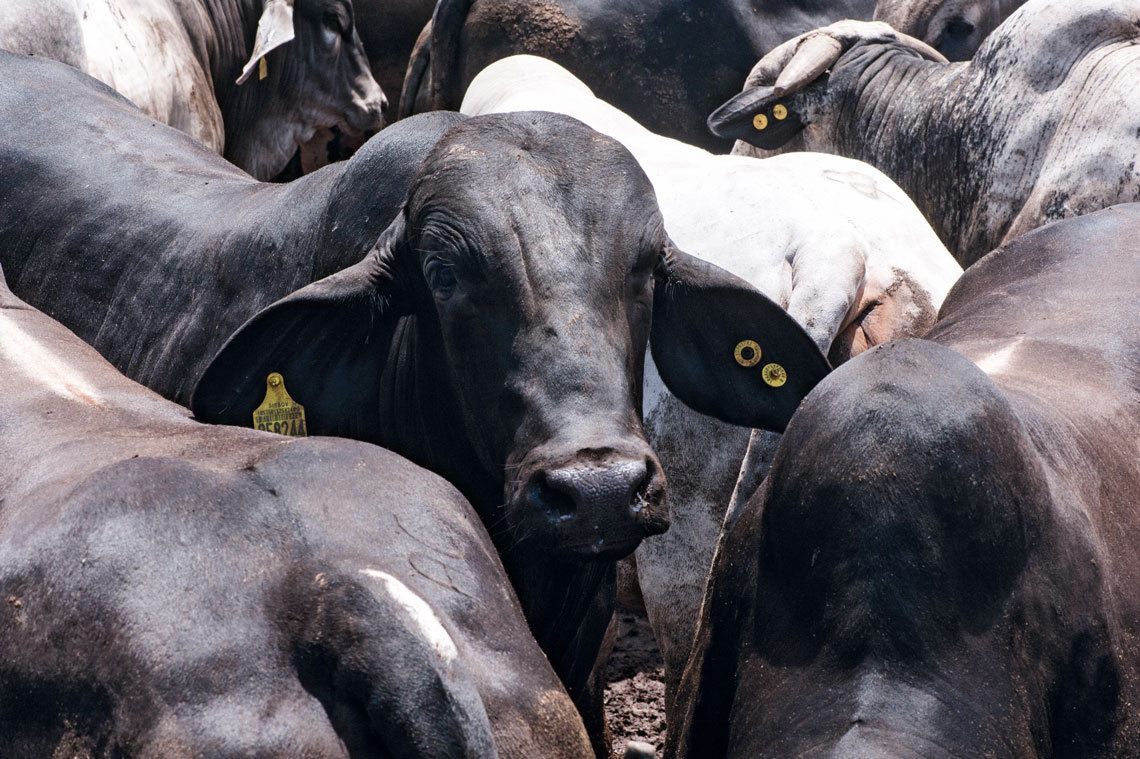
Léo Ramos Chaves
Cattle on the Santa Rosa property in Altair, São Paulo, wear ear tags with chips for identificationLéo Ramos ChavesOne initiative to deploy agriculture 4.0 is being implemented at sugar and ethanol company São Martinho’s operations in Pradópolis, São Paulo, southeastern Brazil. The company has built its own 4G network to transmit data generated by more than 700 farm machines operating across its more than 135,000 hectares of sugarcane fields. The fleet is now connected by six transmission towers to a Farm Operations Center where 50 people monitor indicators in real time.
The connectivity infrastructure was developed over the space of three years in collaboration with the Telecommunications Research and Development Center (CPQD) in Campinas, São Paulo, in an investment of R$60 million funded by the Brazilian Development Bank (BNDES) and the Brazilian Funding Authority for Studies and Projects (FINEP). “The project will reduce operating costs and help identify opportunities for improvement and generation of new business,” says Walter Maccheroni Junior, head of Technology & Innovation at São Martinho. With the 4G network still in its first year of operation, the resulting productivity gains are still being assessed. Maccheroni expects savings to be around R$2 to R$3 per metric ton of harvested cane.
The 4G project developed at CPQD will now be tested for two years at four soybean, maize, cotton, and beef farms in Mato Grosso and Bahia. “We hope to demonstrate that real-time information and the use of IoT applications can significantly improve productivity,” says Fabrício Lira Figueiredo, director of Intelligent Agribusiness Development at CPQD.
Brazilian farmers are largely using IT systems offline, says Figueiredo, meaning operational data is only available when farm equipment returns from the field. Data is often saved to a pen drive one machine at a time, and then processed. The data collected is usable, but only to schedule tasks for the following days. “It is a significant improvement from traditional farming, in which field operations are not systematically monitored, but it is still far from the level of productivity that can be achieved with connected IT systems,” says the CPQD official.
When machines and sensors are connected in real time, explains Figueiredo, data can then be collected by the minute, allowing managers to act on the data immediately. For example, they can adjust the route of a planter that has gone off course, dispatch a sprayer to apply pesticide on a patch where a drone has detected a larval infestation, before it spreads across the field, or reschedule harvester tasks in response to an alert that there will be rainfall on some fields and not others.
Another barrier to digital transformation in agribusiness is that the software running on electronic equipment and devices is often not interoperable. Manufacturers create proprietary operating systems that are not able to exchange information with other firms’ systems. This makes little sense in a world that is moving towards online communication and IoT.
A tentative solution to the problem will be presented in April by the Brazilian Association of Machinery and Equipment Manufacturers (ABIMAQ). The proposed solution will involve the development of a Collaborative Farm Database (BDCA)—a cloud-based big data platform to store data from equipment and sensors—and a software system to adapt and standardize the communication language.
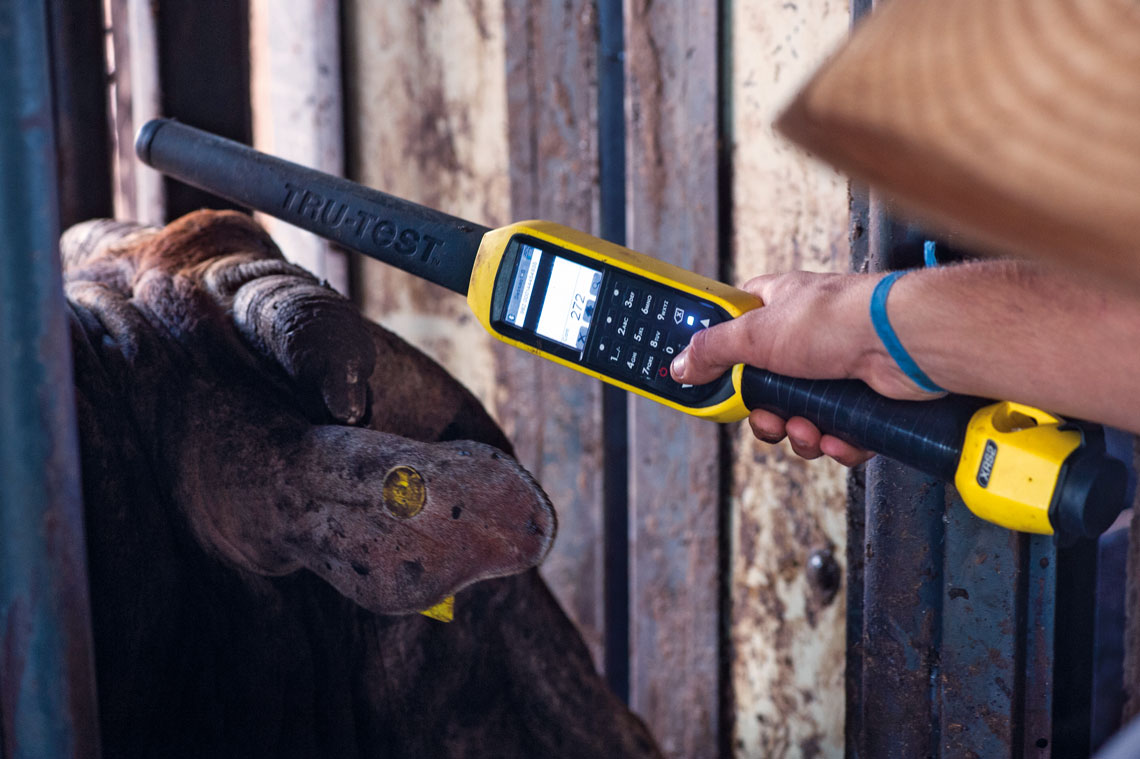
Léo Ramos Chaves
Farmhand uses a wand to collect data about each animal before saleLéo Ramos ChavesPedro Bastos, chairman of the Agricultural Equipment Sector Committee at ABIMAQ, says the information in the database will be used exclusively by farmers and only they will be able to give access permissions to commercial partners and suppliers. “The cost of the service is yet to be determined, but it won’t be expensive as the project is not seeking profit, but to provide a valuable service. To do so we need to build scale,” says Bastos.
CPQD has licensed its rural connectivity technology—a suite of hardware and software—to Trópico Telecomunicações, a firm also based in Campinas. The first deal was signed with US farm equipment manufacturer John Deere. In 2019 the companies launched a service to build on-farm internet connection networks. The networks are built to each client’s connectivity requirements using towers and a transmission system based on Long Term Evolution (LTE) technology.
John Deere provides a platform that integrates the telemetry data from its equipment and onboard sensors with data from farmers’ business partners, such as market analyses and weather forecasts. Felipe Santos, manager for precision farming solutions at John Deere, says on-farm conductivity is essential in enabling farmers to collect, connect, and act on information in real time. And connectivity will soon become even more important. “Software systems and artificial intelligence algorithms will now read the data and control automated equipment autonomously,” he says.
Technologies with these capabilities are already being used on farms. John Deere is currently running tests in Brazil and the US on a system, called See and Spray, that uses cameras and sensors to detect weeds in the field. Artificial intelligence software then controls pesticide application using high-precision nozzles that direct the spray pattern squarely to the selected target, generating herbicide savings while minimizing environmental impact. The system is autonomous and its movements are controlled by GPS.
John Deere is not the only company testing driverless tractors and farm machinery. Italy-based CNH Industrial, which manufactures machinery under the Case and New Holland brands, and Brazil-based Jacto, are currently testing new driverless equipment in Brazil.
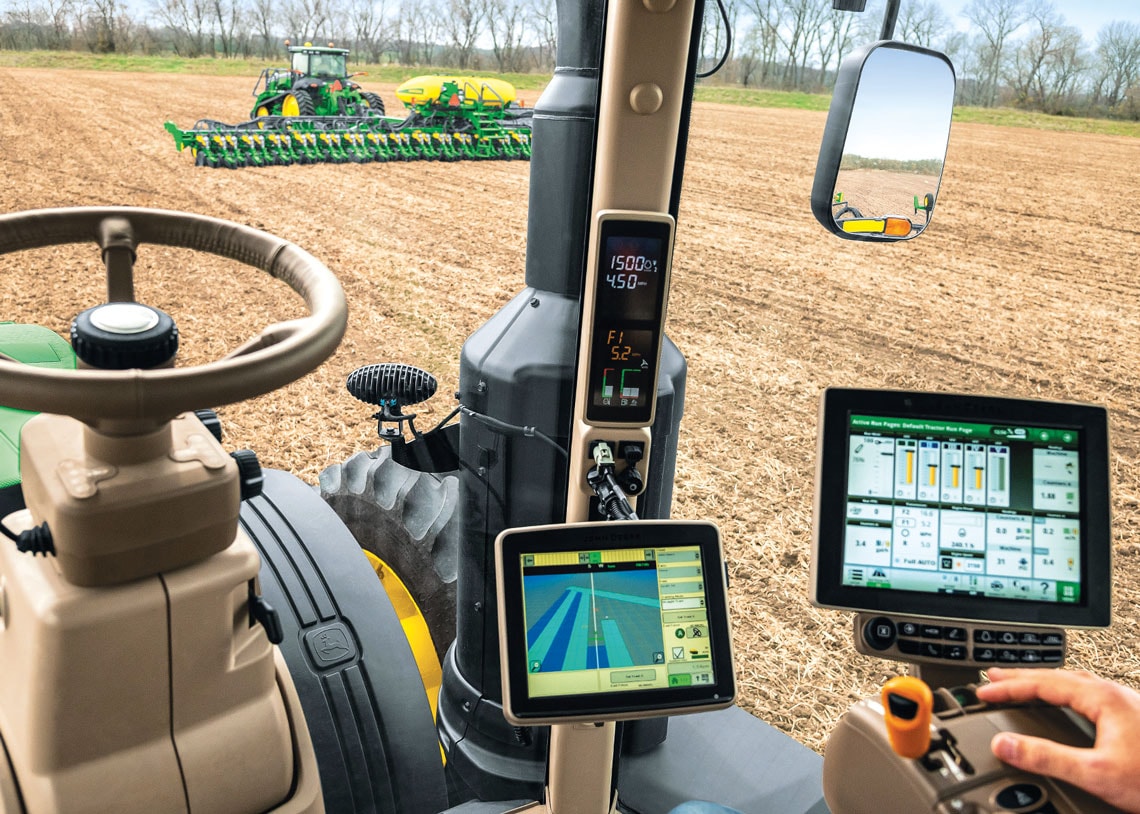
Léo Ramos Chaves
Inside the cab of a highly automated farm machine from John DeereLéo Ramos ChavesJacto also runs a school in Pompeia, São Paulo, the Shinju Nishimura Technology Foundation, that trains workers to use these technologies in the field. The initiative reveals a concern in the industry about the need to reskill workers who have been displaced from farms by advancing technology.
“Modernization has shrunk the number of job posts in agriculture, but at the same time it has created opportunities for higher-skilled labor, including in other agribusiness segments, such as agro-industries and agro-services,” says Nicole Rennó Castro, a researcher at the Center for Advanced Research in Applied Economics (CEPEA) at ESALQ-USP.
Advanced technology platforms are also being used by livestock farmers, such as electronic weighing systems strategically placed at water troughs to collect animal weight data from a distance. Artificial intelligence systems monitor feedlot cattle and alert farmers to the optimal timing for slaughter. Agropastoril Paschoal Campanelli, a company in Bebedouro, in the north of São Paulo State, has extensively used these systems to accelerate the finishing process in precision cattle farming systems.
Another innovative technology, developed at Dutch animal nutrition company DSM, is being tested at the company’s Center for Innovation and Applied Science for Ruminants in Rio Brilhante, Mato Grosso do Sul, Midwest Brazil. In collaboration with the University of Wisconsin, DSM, which markets animal supplements under the Tortuga brand, is developing a 3D camera system to estimate growth and weight gain in beef cattle. The university has also developed a feed bunk management system that uses images to evaluate the quantities of feed delivered and animal behavior throughout the day.
Tiago Sabella Acedo, manager for innovation and applied science at DSM Latin America, explains that currently these checks are done visually, typically once per day, based on the amount of feed that is left in the bunk. This prevents farmers from determining whether only some animals are being fed and others not, even if feed bunks are left empty for an extended period of time, an opportunity missed to optimize the feedlot process. The rationale behind the system is that by monitoring how long feed bunks are left empty, feed quantities can thus be optimized, maximizing animal weight gain.
The need for data connectivity to deliver digital farming solutions led seven agricultural technology firms to create a consortium with telecommunications carrier TIM, called ConectarAgro, that will develop internet connectivity infrastructure throughout Brazil. The consortium will use LTE 4G transmission technology at a frequency of 700 megahertz (MHz). The infrastructure consists of towers, antennas, and radio equipment. “Rural internet connectivity is currently limited. We want to enable more farmers to implement digital transformations on their properties,” says Anselmo Arce, a partner at Solinftec, one of the consortium members.
Solinftec is a Brazilian company created in 2007 by seven Cuban engineers who migrated to Brazil to develop automation solutions for the sugar and ethanol industry. These systems now monitor 8 million hectares of cane fields and grain and fiber crops in 10 countries, including the US. Arce explains that Solinftec uses multiple equipment communications methods to work around the lack of connectivity. The most commonly used method is mesh networking, in which each onboard computer operates as a repeater, mediating communications between equipment and automatically synchronizing tasks.
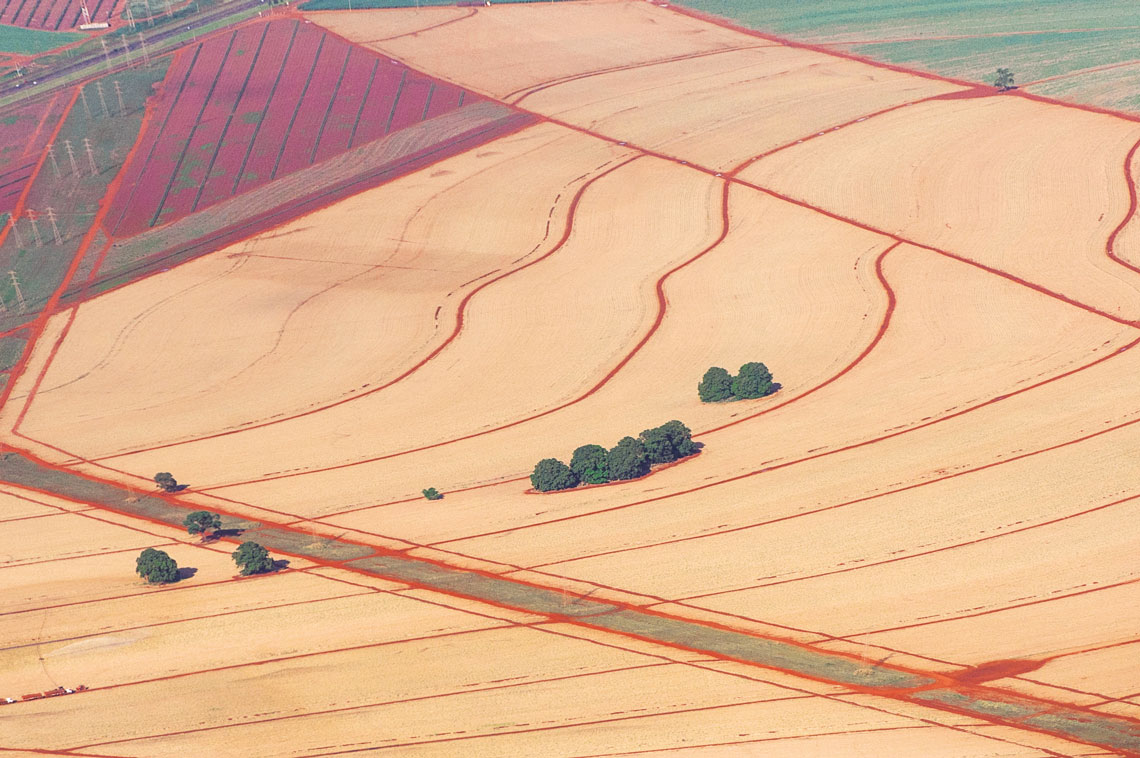
Léo Ramos Chaves
Land ready for planting sugarcane—one of the crops seeing the most intensive use of digital technologies—in Ribeirão Preto, São PauloLéo Ramos ChavesIn its most sophisticated version, called SolinfNet, the mesh network is connected to radio towers that can connect to a central hub at the farm office, supporting two-way communications and real-time action by farm managers. Agribusiness company Terra Santa Agro has implemented the solution on one of its soybean, maize, and cotton farms.
“We’re no longer caught by surprise at the end of the day by machine downtime due to unexpected operational or weather events,” says Márcio Ferreira, a manager at Terra Santa Agro. Relying on precise information to plan planting and harvesting operations, he says, was crucial in enabling the company to turn around seven years of losses and post an operating profit in 2018.
Agribusiness startups—known as agtechs—are working alongside farmers, universities, research centers, and equipment manufacturers to create innovative solutions for farming. “Digital agriculture is a complex ecosystem, and each player has a different role. Multinational manufacturers have launched equipment almost simultaneously in the US and Brazil,” says Fernando Martins. “Startups have developed new technologies for the industry, but some of these innovations are yet to be proven useful and functional on the ground.”
While there is still much to be done in Brazil in terms of connection infrastructure and interoperability—the two biggest obstacles to bringing Brazilian agriculture into the 4.0 era—digital transformation in farming is steadily progressing. In the short term, efficiency gains will largely translate into improved financial health for corporations. In the longer term, digital agriculture will help farmers sustainably increase food supply at affordable prices, without further deforestation.
“The world population is expected to reach approximately 9.8 billion people in 2050,” says Silvia Massruhá of EMBRAPA. “Brazil will need to produce 40% more food to meet growing demand. New technology and digital transformation will play an important role to this end,” she says.
Pioneering internet connectivity in cane fields in southeastern Brazil

São Martinho
The São Martinho Farm Operation Center in Pradópolis, São PauloSão MartinhoSão Martinho, a sugar and ethanol company based in Pradópolis, one of the largest sugarcane producers in the world, developed advanced infrastructure in 2019 combining 4G internet networks with Internet of Things (IoT) applications. The network, created in collaboration with the Center for Telecommunications Research & Development (CPQD) in Campinas (SP), uses Long Term Evolution (LTE) transmission technology optimized for remote areas, allowing 4G signals to reach a radius of up to 30 kilometers from the radio base stations.
Data transmitted to the Farm Operation Center (COA) are stored in a big data warehouse for processing and integration with other systems, such as management software and productivity maps showing production data for individual fields.
Walter Maccheroni Junior, technology and innovation manager at São Martinho, explains that tractors, harvesters, and trucks are equipped with an Intelligent Vehicle Terminal (IVT) that captures and transmits the data, video, and voice information generated by dozens of onboard sensors and equipment.
An ITV functions as a Wi-Fi hotspot and can be used to connect tablets, drones, and other instruments. Interoperability, or the ability of the different systems involved to exchange information with each other, is supported by an open-source IoT software system, called Dojot, also developed at CPQD.
Maccheroni says that a range of different tools using artificial intelligence and machine-learning technologies are already being developed within an ecosystem created by São Martinho to devise new solutions for each stage of the production process. One opportunity that has already been identified is in sugarcane transportation from cane fields to the mill. The company’s fleet of approximately 100 trucks travels 46,000 km each day. Each vehicle is monitored in real time, allowing its geographic location to be tracked and optimal routes to be planned.
São Martinho plans to implement 4G networks at its six other plants over the coming two years. The system, which cost R$60 million to build, can provide savings of between R$48 million and R$72 million per year, says Maccheroni.
A cattle farm in northern São Paulo gets a productivity boost from precision agriculture
The process of herding cattle for slaughter provides a good illustration of the level of automation at the Santa Rosa farm in Altair, northern São Paulo. The operation begins with animals leaving the corral through a narrow alley. Before an animal boards the truck that will take it to the meatpacking plant, an employee places an electronic wand near its ear tag. In a nearby glassed-in booth, information about the bull is displayed on a computer screen. A software system analyzes the information and instantly tells the operator whether the animal is ready for slaughter. If it is, another employee operates a crank that remotely opens a gate leading to the truck; if the animal has not reached the right weight, a second gate opens, leading back to the corral. The entire process takes less than a minute.
The Santa Rosa farm is owned by Agropastoril Paschoal Campanelli, a company in Bebedouro, São Paulo, that is intensively using precision livestock technology in feedlot operations—where cattle are fed rations rather than being allowed to range freely in pasture as is more common in Brazil. The company purchases feeder cattle weighing approximately 400 kilograms and resells them four months later at an average of 570 kg.
“In free-range cattle, the finishing process takes seven to eight months. The faster the animals gain weight, the better for the business,” says Marcelo Campanelli, a manager at the company. The Santa Rosa farm has a feedlot capacity to accommodate 21,500 animals. In 2019 the company sold 75,000 head of cattle, a figure that should increase to 100,000 this year.
“We have lots of intelligence embedded in our operations, from preparing the feed rations delivered to animals, through monitoring animal health and how much they are eating from the feed bunks, to the optimal timing for slaughter,” says Victor Campanelli, who manages the feedlot. “The property has automatic cattle-weighing systems, feed bunks with electronic sensors that indicate how much each group of animals has eaten, and cameras to monitor the herd from a distance. Our feed ration factory is fully automated.”
The Campanelli use the 200 metric tons of manure produced each day on the farm in an environmentally sustainable manner. The material is taken to a composting yard and transformed into organic fertilizer, which is then applied in sugarcane and maize plantations owned by the company. “This reduces our requirement for chemical fertilizers by 50%, and saves us several million reais,” says Marcelo Campanelli. “We use circular economy principles on our properties.”
Technology is creating new opportunities for soybean farmers in Mato Grosso
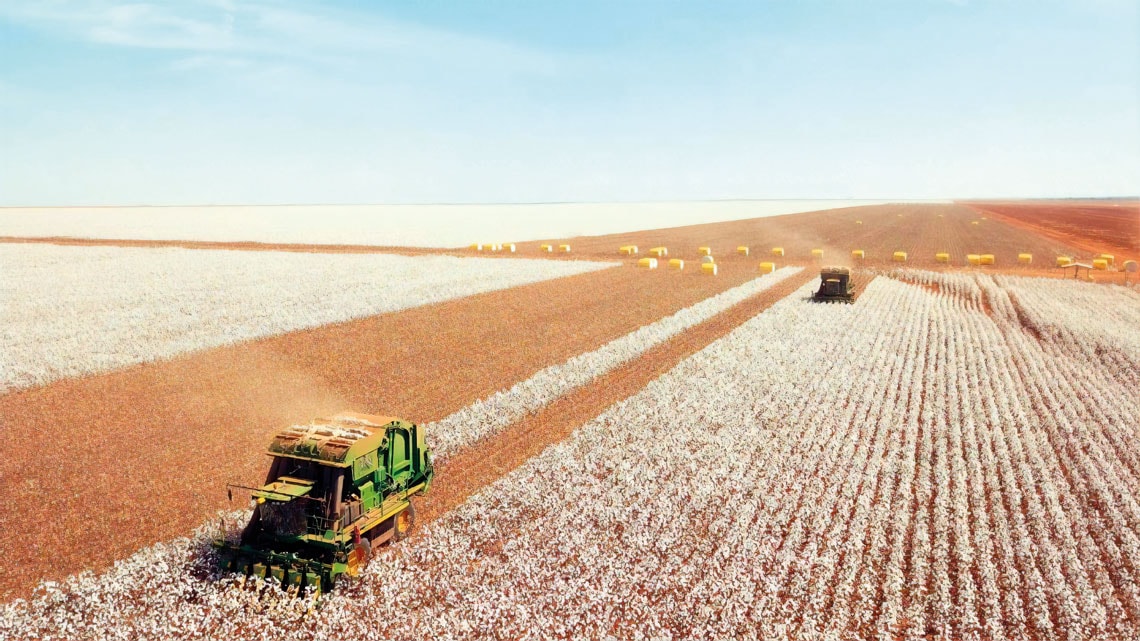
Terra Santa Agro
Machines harvesting cotton on a Terra Santa Agro farm in Mato GrossoTerra Santa AgroPrecision farming using information technology is working a transformation at Terra Santa Agro, one of the largest soybean, maize, and cotton producers in Brazil. The company, which owns seven properties in Mato Grosso, implemented SolinfNet—a farm connectivity system developed by agricultural automation firm Solinftec—on its Mãe Margarida farm in 2016.
With the system, telemetry data from 41 tractors and machines on the farm, which has 13,000 hectares (ha) of cropland, can be monitored in real time from the farm office. The information has also been integrated with two other systems: a farm management and planning system from Gatec, and an enterprise resource planning (ERP) system from Totvs.
“What we have today is like rural big brother. We know exactly what each machine operator is doing at any given time, and are able to act immediately if anything goes off plan or if changes in weather conditions require us to replan farm operations,” says Márcio Ferreira, operations director at Terra Santa. Better planning of tractor, sprayer, and harvester routes, he says, has singly generated fuel savings of approximately 6% and total cost savings of R$ 3.9 million per harvest. The connectivity system will now be expanded to the company’s other farms, two of which should be connected by the next season.
Terra Santa’s biggest priority is to improve control of planting operations in each of the two yearly planting seasons. “We have a short window of time to plant the first crop and there are a number of variables that need to be controlled. A mistake costing a few days could compromise planning for the next crop,” says Ferreira.
Terra Santa saw its first positive operating results in 2018. The company posted net revenue of R$1.1 billion and net income of R$162.4 million. Ferreira credits these results to significant productivity improvements in recent years, partly driven by the use of cutting-edge technology. In the last harvest, soybean yields were 58.5 sacks per hectare, around 26% higher than six years prior, while raw cotton yields were 115.7 sacks/ha, an increase of 20% in the period.
